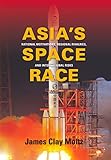Asia's Space Race : National Motivations, Regional Rivalries, and International Risks / James Clay Moltz.
Material type: TextSeries: Contemporary Asia in the WorldPublisher: New York, NY : Columbia University Press, [2011]Copyright date: ©2011Description: 1 online resource (288 p.)Content type:
TextSeries: Contemporary Asia in the WorldPublisher: New York, NY : Columbia University Press, [2011]Copyright date: ©2011Description: 1 online resource (288 p.)Content type: - 9780231156882
- 9780231527576
- 629.4/1095 22
- TL789.8.A78 M65 2012
- TL789.8.A78
- online - DeGruyter
- Issued also in print.
| Item type | Current library | Call number | URL | Status | Notes | Barcode | |
|---|---|---|---|---|---|---|---|
 eBook
eBook
|
Biblioteca "Angelicum" Pont. Univ. S.Tommaso d'Aquino Nuvola online | online - DeGruyter (Browse shelf(Opens below)) | Online access | Not for loan (Accesso limitato) | Accesso per gli utenti autorizzati / Access for authorized users | (dgr)9780231527576 |
Browsing Biblioteca "Angelicum" Pont. Univ. S.Tommaso d'Aquino shelves, Shelving location: Nuvola online Close shelf browser (Hides shelf browser)

|

|

|

|

|

|

|
||
| online - DeGruyter New Perspectives on International Migration and Development / | online - DeGruyter The Lovelorn Ghost and the Magical Monk : Practicing Buddhism in Modern Thailand / | online - DeGruyter Voices from Iraq : A People's History, 2003-2009 / | online - DeGruyter Asia's Space Race : National Motivations, Regional Rivalries, and International Risks / | online - DeGruyter The Columbia Guide to Hiroshima and the Bomb / | online - DeGruyter Confronting Inequality : How Societies Can Choose Inclusive Growth / | online - DeGruyter The Quest for Security : Protection Without Protectionism and the Challenge of Global Governance / |
Frontmatter -- CONTENTS -- Acknowledgments -- INTRODUCTION. Asia's New Presence in Space -- CHAPTER ONE. Asian Space Developments: Motivations and Trends -- CHAPTER TWO. The Japanese Space Program: Moving Toward "Normalcy" -- CHAPTER THREE. The Chinese Space Program: From Turbulent Past to Promising Future -- CHAPTER FOUR. The Indian Space Program: Rising to a Challenge -- CHAPTER FIVE. The South Korean Space Program: Emerging from Dependency -- CHAPTER SIX. Emerging Asian Space Programs: Australia, Indonesia, Malaysia, North Korea, Pakistan, the Philippines, Singapore, Taiwan, Thailand, and Vietnam -- CHAPTER SEVEN Asia's Space Race: Implications for Regional and Global Policy -- Notes -- Index
restricted access online access with authorization star
http://purl.org/coar/access_right/c_16ec
In contrast to the close cooperation practiced among European states, space relations among Asian states have become increasingly tense. If current trends continue, the Asian civilian space competition could become a military race. To better understand these emerging dynamics, James Clay Moltz conducts the first in-depth policy analysis of Asia's fourteen leading space programs, concentrating especially on developments in China, Japan, India, and South Korea.Moltz isolates the domestic motivations driving Asia's space actors, revisiting critical events such as China's 2007 antisatellite weapons test and manned flights, Japan's successful Kaguya lunar mission and Kibo module for the International Space Station (ISS), India's Chandrayaan lunar mission, and South Korea's astronaut visit to the ISS, along with plans to establish independent space-launch capability. He investigates these nations' divergent space goals and their tendency to focus on national solutions and self-reliance rather than regionwide cooperation and multilateral initiatives. He concludes with recommendations for improved intra-Asian space cooperation and regional conflict prevention.Moltz also considers America's efforts to engage Asia's space programs in joint activities and the prospects for future U.S. space leadership. He extends his analysis to the relationship between space programs and economic development in Australia, Indonesia, Malaysia, North Korea, Pakistan, the Philippines, Singapore, Taiwan, Thailand, and Vietnam, making this a key text for international relations and Asian studies scholars.
Issued also in print.
Mode of access: Internet via World Wide Web.
In English.
Description based on online resource; title from PDF title page (publisher's Web site, viewed 02. Mrz 2022)


